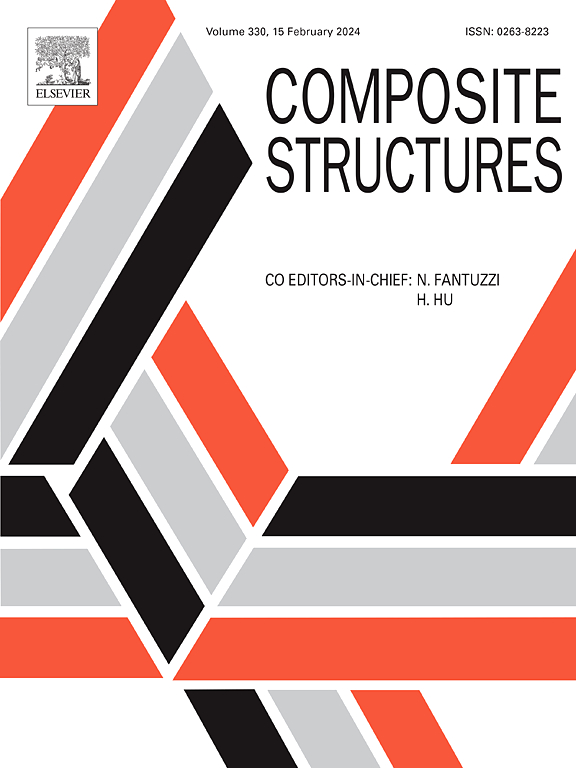不同聚合物基质亚麻纤维复合材料的蠕变性能和寿命
IF 6.3
2区 材料科学
Q1 MATERIALS SCIENCE, COMPOSITES
引用次数: 0
摘要
尽管用天然纤维增强的热塑性聚合物复合材料(tpc)具有很好的结构应用前景,但对其长期性能的了解仍然不够充分,这往往导致复合材料结构的过度设计。这项工作旨在深入了解亚麻纤维增强tpc在承载应用中的长期蠕变行为,重点是在四种不同的热塑性聚合物-聚丙烯,聚氧乙烯,聚酰胺11和聚乳酸中选择最佳的热塑性聚合物,以环氧树脂为基准。对纯聚合物和复合材料的短期蠕变试验表明,尽管聚合物的粘弹性是蠕变的主要来源,但纤维/基体界面对复合材料蠕变响应的影响比基体本身更大。使用定制设计的弯曲蠕变装置进行“运行至失效”测试。采用基于能量的蠕变断裂模型对蠕变寿命进行了分析。利用声发射和扫描电镜分别分析了蠕变损伤演化和断裂机制。在四种tpc中,亚麻/聚乳酸复合材料的使用寿命最长,这是由于其优越的界面性能、增强的抗蠕变性能、更高的储能极限和较慢的损伤发展。与亚麻/环氧复合材料相比,在150 MPa的相同应力下,这四种TPCs的寿命明显缩短(缩短了一到三个数量级)。然而,在相同的应力比为80%的情况下,与亚麻/环氧复合材料相比,四种tpc表现出更小的蠕变寿命差异,这表明它们在低至中等承重结构部件上的潜在应用。本文章由计算机程序翻译,如有差异,请以英文原文为准。
Creep behaviour and lifespan of flax fibre composites with different polymer matrices
Despite the promising structural applications of thermoplastic polymer composites (TPCs) reinforced with natural fibres, their long-term performance remains insufficiently understood, which often results in the overdesign of composite structures. This work aims to gain a deeper understanding of the long-term creep behaviour of flax fibre-reinforced TPCs for load-bearing applications, focusing on selecting an optimal thermoplastic polymer among four different thermoplastic polymers − polypropylene, polyoxymethylene, polyamide 11, and polylactic acid, using epoxy as a benchmark. Short-term creep tests on the neat polymers and the composites reveal that the fibre/matrix interface plays a more important role in the creep response of the composites than the matrix itself, despite the polymer’s viscoelastic nature being the primary source of creep. “Run to failure” tests were performed using a custom-designed flexural creep set-up. The creep lifespan was analysed using an energy-based creep rupture model. Acoustic emission and scanning electron microscope were used to analyse creep damage evolution and rupture mechanisms, respectively. The longest lifespan among the four TPCs was observed in flax/polylactic acid composite, attributed to its superior interface properties, enhanced creep resistance, higher stored energy limit, and slower damage development. When compared with flax/epoxy composite under a same stress of 150 MPa, the four TPCs demonstrated a significantly shorter lifespan (one to three orders of magnitude shorter). Under a same stress ratio of 80 %, however, the four TPCs exhibited less disparate creep lifespan compared to flax/epoxy composite, suggesting their potential applications for low to medium load-bearing structural components.
求助全文
通过发布文献求助,成功后即可免费获取论文全文。
去求助
来源期刊

Composite Structures
工程技术-材料科学:复合
CiteScore
12.00
自引率
12.70%
发文量
1246
审稿时长
78 days
期刊介绍:
The past few decades have seen outstanding advances in the use of composite materials in structural applications. There can be little doubt that, within engineering circles, composites have revolutionised traditional design concepts and made possible an unparalleled range of new and exciting possibilities as viable materials for construction. Composite Structures, an International Journal, disseminates knowledge between users, manufacturers, designers and researchers involved in structures or structural components manufactured using composite materials.
The journal publishes papers which contribute to knowledge in the use of composite materials in engineering structures. Papers deal with design, research and development studies, experimental investigations, theoretical analysis and fabrication techniques relevant to the application of composites in load-bearing components for assemblies, ranging from individual components such as plates and shells to complete composite structures.
 求助内容:
求助内容: 应助结果提醒方式:
应助结果提醒方式:


